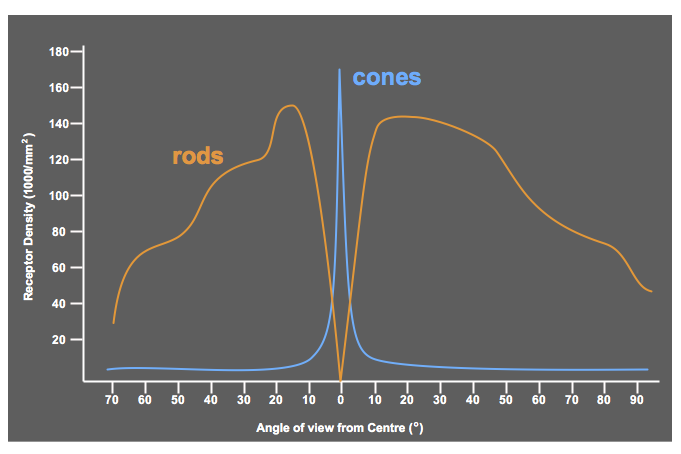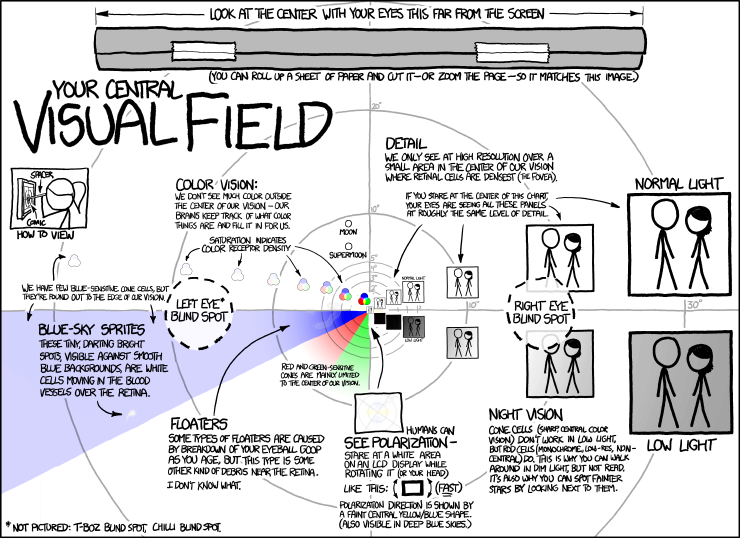Retina
The human eye is incredible. And our ability to use this to work out so much about the world is remarkable. It’s even more impressive when you realise that there are huge limitations and so much trickery involved, and that you don’t ‘see’ everything you believe you do. This post is about the ability for your eye to capture information in the world, for your brain to use. In later posts we will look at how that is processed into useful information in the brain and an understanding of the world.
- When you look at a scene, like a park on a sunny day, you feel like you take in a pretty accurate view of the whole scene in front of you. In fact the amount of your vision that is detailed is tiny – just the size of your thumbnail held at arms length away from you. Outside of this the detail reduces dramatically, and it takes constant scanning to take in detail from different parts of the scene.
- This tiny disk of detail is swept around the scene in front of you in tiny, jerky, and mostly involuntary movements called saccades, During these movements you effectively see nothing.
- You have over 100million photo receptors (think of light detecting pixels) in each eye that detect light, but only around 1 million neurons to transmit this information to the brain, so something pretty tricky is going on to transmit all even this limited detail.
- The effort needed to process vision is huge, and a large amount of the brain’s capacity is given over to it. This is all very expensive in terms of energy, and your brain is very good at saving energy by avoiding any work that is not very important (according to its own priorities). This means that only parts of the visual information are ever processed at all, or given any attention.

How much of the world can we see?
Experiments
Range of Vision
Limits of detail
Your laser beam of focus
Photoreceptors: Our Pixels

Photoreceptor density
As you move away from the centre of the eye, the number of cells that pick up colour and light data dramatically reduce. Cones detect detail and colour in normal daylight. Rods detect light (but no colour) in low light conditions.
Retina Illustration
Let’s look at a simulation of cone density and what vision might look like if you could intercept the signals from these photo receptors.
How to use this illustration
This simulated retina in this illustration has around six thousand cones compared to six million in a human retina.
How Much Detail Can You See?
How to use this illustration
Retina Rings
- a central, small area of high detail colour perception
- a ring with detail but less colour
- a less detailed very low colour ring
- just very scant light/dark detection over the rest of our visual field.
How to use this illustration
Use the first panel to control where your view is focused, the second panel shows the result. You can choose a different scene to view in the last panel.
Experiment: colour and detail limits
Saccades
How to use this illustration
The first, top panel shows you where in the scene your retina is focused. below this we can see the uninterrupted stream received from the retina, including the blurring effect during rapid movements. The main panel shows the effect if the feed from the retina is ignored (shown as a black disk) during movements, but the steady images are combined with the (rapidly decaying) information about the whole scene. In the end panel you can switch scenes.
Experiment: Saccades
- Find a book, or something with lots of text on it.
- Hold your phone in one hand, switch to the front facing camera and pick video mode on the camera app.
- Move the phone until your eye (on the same side as the hand holding the phone) is in the frame, but your other eye is not blocked by the phone.
- Now hold the book in front your other eye.
- Press record on the phone and now read for a few seconds.
- Stop recording, and play back the recording.
Experiment: Saccades 2
Look in a mirror and try this (it must be a real mirror, and not a mobile phone app)
While you look at your own reflection, shift your gaze from looking at one of your eyes to the other and back again. You will be able to see that your eye has moved, but you cannot see the move. Why not? Because your brain blocks the feed from your eye during the saccade.
Repeat the same experiment stood in front of another person and ask them to switch their gaze from one of your eyes to to the other and back again. Watch their eyes while they do this. You can see the movement in their eyes, that you could not see in your own in the mirror.
Summary
The Science and Other Sources
If you want to know more, the best reference I have found so far on human vision is Vision and Brain: How We Perceive the World, by James V. Stone, published by MIT Press. It’s heavy in places but it covers many aspects that are useful.
Also interesting is Visual Intelligence: How We Create What We See by Donald Hoffmann.
Some of the most interesting observations about how we don;t experience what we think we do are in The Mind is Flat: The Illusion of Mental Depth and the Improvised Mind, by Nick Chater
Both go far beyond what is captured by the eye, but they give great overviews of how vision works based on what we receive from our eyes, and what we do with it in order to “see” anything.
For some other quick and fascinating facts about the eye, take a look at this XKCD cartoon.

Above I refer to some experiments that look into how far away from the centre of your vision you are unaware of text during reading (even if it changes). This comes from the Nick Chater book (The Mind is Flat), where he references a paper:
Related Thoughts
TV Screens
The Magic of Paintings.
An Artist’s Retina


The Images used in the illustrations
The image of monkeys is the authors own. The text for the illustrations is from a thought posted by David McRaney, author and podcaster of the amazing You Are Not So Smart podcast.
Other Experiences
An obvious flaw here is that my focus in this article has been about how we see; so what if you cannot see at all, or you do not see in the way that many others do?
The human brain devotes a huge amount of space and ability to vision, in what is called the visual cortex. It is one of the unique features of the human brain. But it is a bit misleading to call it visual. A lot of it is to do with spacial reasoning, or understanding relationships between things, and the properties of objects. It turns out that those projections of the world and predictions about objects, where they are, what they mean (to you, eg. food, danger) are active in almost the same way with our other senses. If someone is blind or visually impaired, their cortex responds in similar ways to when a sighted person sees something. Even as a sighted person, you can shut your eyes and be able to tell what kind of space you are in from the way that sounds reverberate, and what kinds of sounds you hear. You can tell if you are inside or outside, how large the space is is, whether you are alone, or with a few or many people. If your world is without vision altogether you will be even better at this. We use these spacial reasoning abilities even for abstract ideas that don’t originate from any sense. When you imagine the relationships between people you know, your family, how something works, and when you make plans by imagining a sequence of tasks, you are using these same pieces of brain machinery, and mental powers.
Just think for a moment how movies, animated cartoons, computers/phones, and more recently virtual and augmented reality deliberately fool our senses in order to make our minds project something that is not there, as though it is. They work because designers and programmers are learning how to plant compelling ideas in your mind, and trigger the senses in a way that enhances those ideas.
You may have been born with exceptional attention to detail, or amazing spacial reasoning that makes you great at solving certain kinds of problems, but poor at noticing subtle signals of people’s behaviour around you. It is unlikely that your eyes work very differently, but how your mind processes, prioritises, and adds meaning to the view can be very different for the person standing right next to you, looking at the same scene.
There are things that can go wrong in brain mechanics. So for example, certain areas of the brain can become damaged (maybe as a result of a stroke or injury), and prevent a person from being able to process their perfectly working sense images from the eye into meaningful objects, or faces. These can be distressing and debilitating. Sometimes the plasticity of the brain (its ability to reconfigure its connections) can compensate for such damage, but often it cannot.
Our beliefs about the world can have a huge affect on what we see in a scene. It can affect what we decide is important for us to place our limited focus on, so that we may miss other details, and we may assess something as being benign, while the person next to us sees something threatening. Conditions and diseases, such as dementia, can cause sufferers to hold a different set of beliefs about where they are, who they are with, what year it is, and thus have a very different projection on the same scene as you are seeing.
I am here visiting some of the reasons why any individuals experience of vision could be wildly different from mine, but still concluding that the ideas illustrated above are relevant, and maybe even explain why one person’s experience of a scene can be so very different from another’s.
